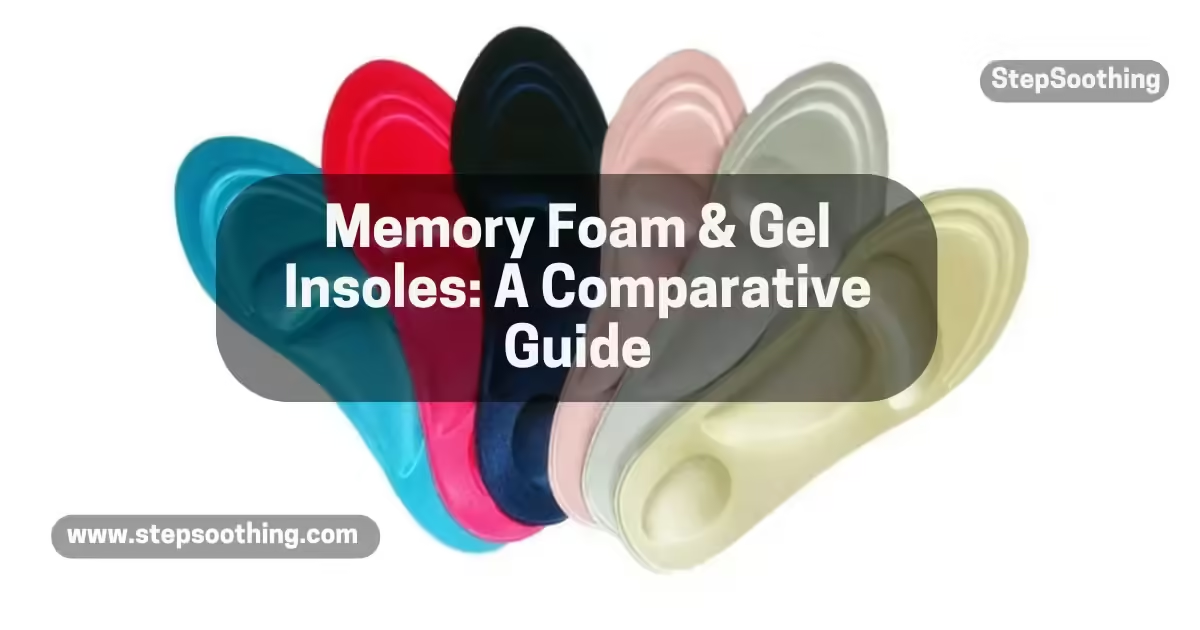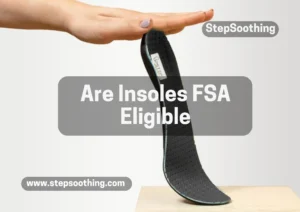Comfortable insoles play a crucial role in foot health and overall well-being. The market for foot orthotic insoles is growing rapidly, with projections estimating it will reach $5,741.00 million by 2031. Two popular types of insoles dominate this market: memory foam and gel insoles. Each type offers unique benefits and drawbacks.
Key Differences Between Gel and Memory Foam Insoles

Choosing the right insoles for your shoes can significantly improve your comfort and foot health. Two of the most popular options are gel insoles and memory foam insoles. Both types offer distinct benefits, such as improved shock absorption, pressure relief, and foot support, but they perform differently based on your activity level and foot needs. This article will help you understand the key differences between gel and memory foam insoles so you can make the best choice for your well-being.
What Makes Memory Foam Insoles Unique?

Memory Foam Insoles are made from viscoelastic materials, such as polyurethane, which can mold to your foot shape and provide a personalized fit. The soft, cushioning material conforms to the contours of your feet, offering immediate pressure relief for people who suffer from foot pain, plantar fasciitis, or arch collapse. These insoles distribute pressure evenly, which is beneficial if you spend a lot of time standing or walking. They also offer good shock absorption, protecting your joints from the impact of walking or running.
However, memory foam has a tendency to retain heat, which can lead to discomfort over prolonged use, especially in warm conditions. The thickness of memory foam also contributes to its cushioning, but it can make your shoes feel warmer. Although memory foam insoles are comfortable, they may not be as breathable as gel options.
How Do Gel Insoles Work?

Gel Insoles are designed to provide cushioning and shock absorption through a flexible gel structure. Unlike memory foam, which molds to the foot, gel insoles have a bouncy, responsive feel that helps disperse pressure across your foot, making them ideal for high-activity individuals. These insoles also promote airflow and temperature regulation, keeping your feet cooler and reducing moisture buildup, which is important if you’re standing or walking for long periods.
Gel insoles are great for activities that involve repetitive high-impact movements like running or jumping because they provide immediate shock absorption and reduce the strain on your joints and muscles. While gel insoles are typically more lightweight and flexible than memory foam, they may not provide as much contouring or personalized fit as memory foam.
Which Insoles Offer Better Shock Absorption?
Both gel and memory foam insoles offer shock absorption, but they do it differently. Memory foam absorbs impact by distributing pressure evenly across the entire foot, making it a great option for daily activities like walking or standing. The foam’s ability to mold to your foot shape ensures that the entire foot is cushioned, reducing foot pain and the risk of foot conditions like plantar fasciitis.
On the other hand, gel insoles are designed to absorb higher levels of shock during activities like running or jumping. They are particularly good for absorbing high-impact stress on your heel and arch, which helps protect your feet from injury. If you’re someone who engages in vigorous activities, gel insoles may offer better overall shock absorption.

Are Memory Foam Insoles Good for Foot Conditions?
If you suffer from foot conditions like plantar fasciitis, memory foam insoles are an excellent choice for providing relief. The foam contours to your foot, offering support and reducing pressure on sensitive areas like the arch and heel. This helps prevent conditions like overpronation or flat feet from worsening. Memory foam’s ability to mold to your foot makes it perfect for providing a custom fit and immediate relief from foot pain.
Which Insoles Are Better for High-Impact Activities?
If you’re involved in high-impact sports like running or jumping, gel insoles are likely a better choice. The gel structure is designed to withstand the repeated impact that comes with these activities, providing better protection for your joints and muscles. Gel insoles are also more adaptable to different foot shapes and provide a cooling sensation that prevents overheating during long, strenuous activities.
Memory foam insoles, while great for everyday use, may compress over time and lose their ability to absorb impact during vigorous activities. They are better suited for low-intensity activities like walking or standing for prolonged periods.
How Do These Insoles Handle Temperature and Moisture?
One major advantage of gel insoles is their ability to regulate temperature and airflow, making them more breathable than memory foam. The gel structure allows for better air circulation, keeping your feet cooler and preventing the buildup of moisture, which is especially important if you are wearing your insoles for extended periods or in hot conditions. Gel insoles are also less likely to retain heat, making them ideal for people who tend to have sweaty feet.
Memory foam insoles, on the other hand, are not as efficient at temperature regulation. Due to their dense structure, memory foam can trap heat, which may lead to discomfort, especially in warmer climates. Some modern memory foam insoles come with breathable designs, but they may still not match the cooling capabilities of gel insoles.
Which Insoles Are More Durable?
When it comes to durability, both memory foam and gel insoles offer long-lasting comfort, but they wear down differently. Memory foam insoles tend to compress over time, which can reduce their ability to provide shock absorption and pressure relief. This means they may need to be replaced more frequently, especially if used for high-impact activities.
In contrast, gel insoles are more resistant to wear and tear. The gel material maintains its shape better over time, offering consistent support and shock absorption, even after prolonged use. For people looking for a more durable option, gel insoles may be the better choice, especially for those who are on their feet a lot or engage in active sports.
Can These Insoles Help with Plantar Fasciitis?
Both gel and memory foam insoles can help relieve symptoms of plantar fasciitis by providing extra cushioning and shock absorption. Memory foam insoles are particularly effective because they mold to your foot shape, which can alleviate pressure on the heel and arch, reducing foot pain. This custom fit can help prevent further irritation of the plantar fascia.
On the other hand, gel insoles may be a better choice for active individuals with plantar fasciitis. Their superior shock absorption can reduce the impact on your feet during high-intensity activities, which helps prevent the condition from worsening.

Which Insoles Are Better for Casual or Standing Use?
If you’re looking for insoles for casual use or if you spend long hours standing, both memory foam and gel insoles can provide significant benefits. Memory foam insoles are excellent for all-day comfort, especially if you are standing or walking for long periods. They provide consistent support and evenly distribute pressure, making them ideal for office workers or people with preexisting conditions like flat feet.
For those who need more shock absorption and cooling, gel insoles may be a better option, especially in hot climates or for those who need to stand for extended periods. The cooling effect of gel insoles can prevent your feet from overheating, and the gel structure ensures that your feet stay comfortable even during prolonged use.
How Does Price Compare Between Gel and Memory Foam Insoles?
When it comes to price, both memory foam and gel insoles can vary depending on their features and brand. Generally, memory foam insoles tend to be more affordable, making them a great option for those on a budget who still want comfort and support.
Gel insoles, on the other hand, may come with a higher price tag, especially if they include advanced features like enhanced shock absorption or cooling effects. However, their durability and ability to withstand high-impact activities can make them a better long-term investment for those who need insoles for running, jumping, or other strenuous activities.
Key Takeaways:
- Memory foam insoles offer customized comfort, molding to your foot and providing even pressure distribution, making them ideal for casual or low-intensity activities.
- Gel insoles are better for high-impact activities like running and jumping, thanks to their superior shock absorption and cooling effects.
- Memory foam can retain heat, while gel promotes better airflow and temperature regulation, making it a better choice for long periods of standing or walking.
- Both types of insoles can help relieve symptoms of plantar fasciitis and other foot conditions, though gel insoles may offer more durability.
- Price differences vary, with memory foam insoles being more affordable, while gel insoles may provide better long-term value due to their durability.
Choosing between memory foam and gel insoles depends on your specific needs. For all-day comfort, memory foam is a great choice, but for active individuals, gel insoles offer enhanced performance.
People Also Asked
What are the key differences between memory foam and gel insoles?
Memory foam insoles offer superior cushioning and personalized support, while gel insoles excel at shock absorption and provide a cooling effect. Memory foam is more durable, but gel is more flexible.
What are the main benefits of memory foam insoles?
Memory foam insoles provide excellent cushioning and pressure relief, making them ideal for individuals with foot pain or conditions like plantar fasciitis. They also exhibit good durability over time.
What are the advantages of gel insoles?
Gel insoles offer superior shock absorption, which benefits active individuals and those with foot conditions. They also provide a cooling effect that helps dissipate heat, making them suitable for warmer climates.
Which type of insole is more cost-effective in the long run?
Memory foam insoles generally have a higher upfront cost, but their superior durability may make them more cost-effective in the long run compared to gel insoles, which may require more frequent replacement.
For what types of activities or use cases are each insole type best suited?
Memory foam insoles are ideal for office workers, individuals with foot conditions, and those seeking long-term comfort and support. Gel insoles are better suited for athletes, active individuals, and those needing immediate shock absorption and cooling relief.



